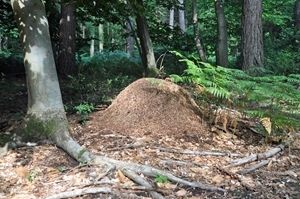The wood ant
 Before I take a specific look at the wood ant, let’s set the scene on ants in general.
Before I take a specific look at the wood ant, let’s set the scene on ants in general.
There are more ants roaming around the world than any other creature on the planet and it is estimated that 10% of the animal biomass of the world is composed of ants.
Relative to their size, ants have the largest brain of any insect. A human brain has 10,000 million cells, while an ant brain has 25,000. So get this - a colony that has 40,000 ants within it, is equal to one human brain. (Remember that some Wood ant nests can have 250,000 ants present!)
If we could run as fast as an ant for its size, we would be able to quite easily keep up with a racehorse and as an ant can lift 100 times its own weight, we would be able to lift up a bus.
OK – scene set – let’s now take a look at the wood ant!
Wood ants have a reddish thorax, dark head and abdomen and are big. Formica rufa – the wood ant species on which I’m going to concentrate – is the largest ant in the UK, with workers reaching 10mm. As their name suggests, they are associated with woodland, being found mostly in coniferous forest but also in mixed and broadleaved forests. South-facing, well-drained areas are favoured and this is where they choose to build their thatched nest mounds, which they will defend aggressively.
A wood ant nest is an amazing construction, with the heart of the nest being deep underground comprising a series of tunnels and chambers. The domed “thatch” that makes up the structure we see, is made of materials such as pine needles, small twigs, moss, heather, dried grass and even pieces of lichen. Pine resin within the needles used for the thatch has antibacterial properties, so by incorporating them into their nests, wood ants are protected from bacteria and fungi that could otherwise harm them.
The thatch is made in such a way that it intercepts the sun’s rays at right angles, acting like a solar panel to raise the temperature of the nest above that of the surroundings. This is important for the development of the brood inside the nest and to keep the workers warm enough to remain active, even on cool days.
Workers will move the brood up and down the nest in order to provide them with the optimal temperatures for growth, sometimes bringing them onto the surface of the nest for an extra boost of warmth from the sun. The thatch acts as an umbrella for the nest and can sometimes reach a metre in height, with each piece laid in a precise manner so that rain water trickles away from the nest, keeping it dry.
Wood ants are predatory insects and feed on a variety of other insects including caterpillars, beetles, and even other ant species. However 90% of their diet comes from honeydew produced by aphids. Aphids feed on tree sap which is high in sugars and as they feed they excrete any excess sugars as honeydew. Ants “milk” the aphids of their honeydew, and in return protect the aphids from predators and even move them to better feeding grounds.
Wood ants are commonly seen moving up the trunks of pine trees, sometimes 30m tall, to collect honeydew from pine aphids living high in the tree canopy. With abdomens distended from honeydew, the ants return to the nest to regurgitate honeydew for the queen and other workers.
In common with most ants, wood ants live in colonies ruled by a queen who is responsible for laying eggs that mature to become all the other workers in the nest. The whole colony acts as one organism with interchangeable roles and for the most part are all female – which is probably why it works!
Although the life expectancy of a worker is only around 60 days, a queen Wood ant can live for an incredible 15 years or more.
Wood ant nests also provide a home for some other insects, known as myrmecophilous species – literally meaning “fond of, associated with, or benefited by ants”. One such insect has the superb name of the shining guest ant and is only ever found inside wood ant nests. A woodlouse with the impressive scientific name of Platyarthrus hoffmannseggii has become so specialised, living in the dark chambers of the nest, that it has lost its eyes and pigmentation.
There are also a number of rove beetles which live in wood ant nests, but these are unwelcome guests, feeding on the ant brood. To avoid detection these beetles produce chemicals which disguise their presence and some go as far as producing sweet secretions from glands which the ants can’t resist and allow the beetle to roam about the nest unharmed.
So, I think you will agree – it’s all happening on the woodland floor!
Peter Thompson
Advisory
Read more from Peter Thompson at the Fresh from the Field blog.